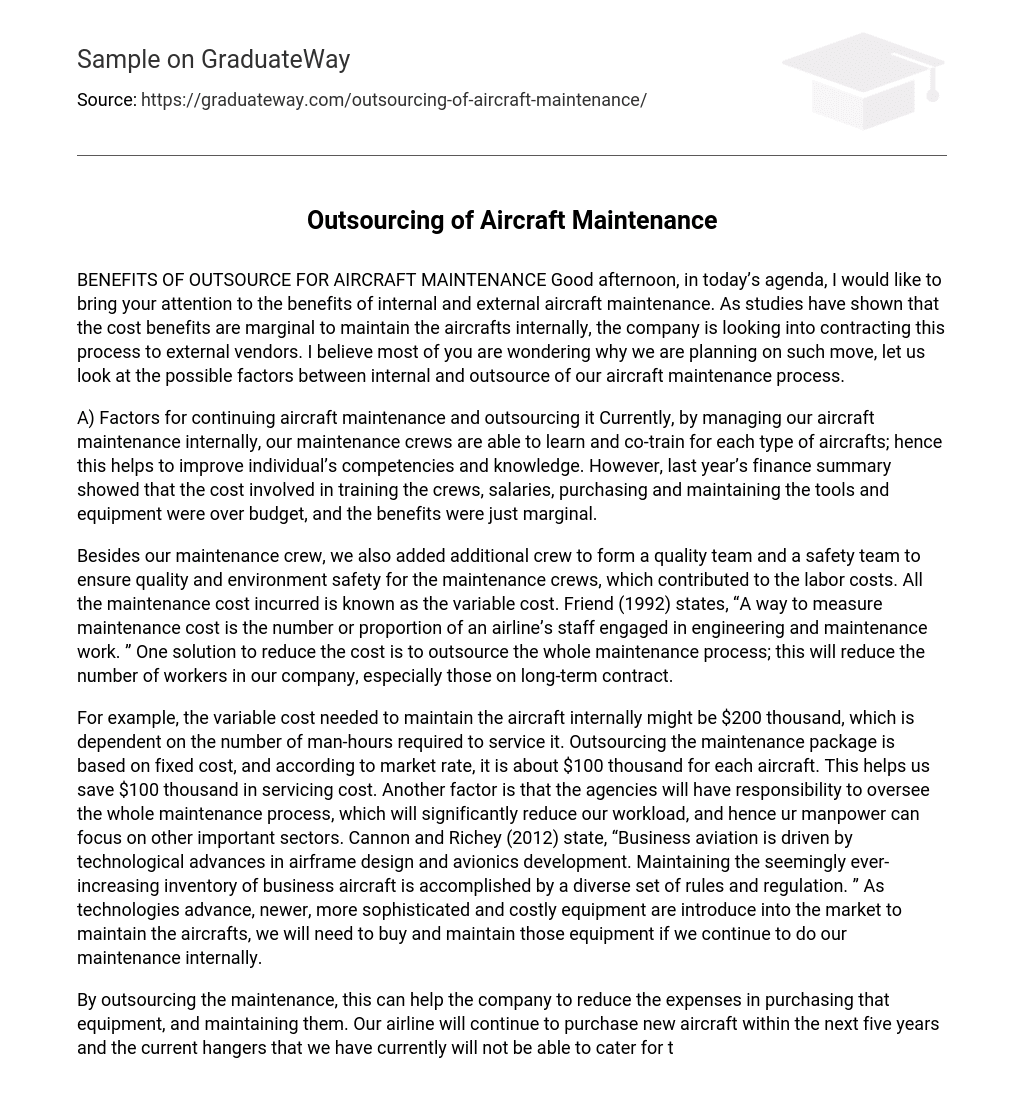Good afternoon, today we will discuss the advantages of both internal and external aircraft maintenance. Recent studies have shown that the cost benefits of internal maintenance are minimal, so our company is considering outsourcing this process to external vendors. You may be wondering why we are considering this change, so let’s analyze the potential factors involved in both internal and outsourced aircraft maintenance.
Currently, by managing our aircraft maintenance internally, our maintenance crews can enhance their competencies and knowledge by learning and co-training for each type of aircraft. However, last year’s finance summary revealed that the expenses for crew training, salaries, purchasing, and equipment upkeep exceeded the budget, resulting in only minimal benefits.
We have expanded our maintenance team by increasing the number of crew members. This has led to the creation of two teams: a quality team and a safety team. These teams are responsible for ensuring that our maintenance crews maintain high standards of quality and environmental safety. Consequently, labor costs have been impacted. All costs related to maintenance are considered variable costs. According to Friend (1992), one approach to measuring maintenance cost is examining the number or proportion of staff members engaged in engineering and maintenance work at an airline. To decrease expenses, outsourcing the entire maintenance process could be a potential solution as it would result in fewer workers employed by our company, particularly those with long-term contracts.
For instance, the aircraft’s internal maintenance cost can vary depending on the number of man-hours needed for servicing, typically around $200 thousand. Nonetheless, by outsourcing the maintenance package, we can save approximately $100 thousand per aircraft at market rates. This not only leads to a reduction in servicing expenses but also enables us to delegate supervision of the entire maintenance process to agencies. Consequently, our workforce can dedicate their efforts towards other crucial sectors.
Cannon and Richey (2012) argue that business aviation is propelled by the advancement of airframe design and avionics technology. To ensure the upkeep of the increasing number of business aircraft, several regulations are implemented. With technological advancements, more sophisticated and costly equipment is introduced to support these aircraft. Consequently, if we choose to handle maintenance internally, we will be responsible for acquiring and maintaining such equipment.
Outsourcing maintenance helps the company save costs on equipment purchase and upkeep. However, our current hangars cannot accommodate the new aircraft that will be acquired in the next five years for servicing the entire fleet. If we decide to stick with internal maintenance, constructing a new hangar would be necessary in the near future. On the other hand, outsourcing allows us to potentially generate revenue by selling or renting out space in our existing hangars.
Cannon and Richey (2012) emphasize that the business aviation fleet relies on the expertise of maintenance managers and technicians who oversee countless ramps and hangers worldwide. However, concerns regarding maintenance standards from external agencies, compliance with deadlines, and potential impacts on flight safety and reputation remain.
Decision on adopting external agencies maintenance: Due to the marginal cost benefits of our current situation, I recommend outsourcing the maintenance. Although maintaining the upkeep internally may potentially allow for better quality control, we should still consider external agencies. According to Sheehan (2003), “A properly certificated repair station offers the advantage of written minimum personnel qualifications, supervisory methods, quality control programs, and increased surveillance from the national regulatory authority.”
Additionally, an Approved Maintenance Organization, or AMO, typically offers a greater depth of personnel and experience for a specific task. Through these professional services, we can minimize the time it takes to turn around aircrafts, thus preventing passengers from experiencing inconvenience caused by technical issues. Furthermore, we have the opportunity to assign some of our technicians to an external maintenance agency, allowing them to gain valuable training and improve their competency in servicing procedures. This arrangement benefits both our technicians and enhances their skills.
Having technicians on site sends a clear message to agencies about our commitment to quality. They can also serve as a point of contact in case of any production disputes or delays. Outsourcing also provides the advantage of saving on fuel costs. In order to maintain our aircraft’s servicing, it needs to return to the hub. If this is not possible, we have to perform advance service in order to avoid maintenance issues when the aircraft is deployed to other countries.
By utilizing worldwide outsourcing maintenance services, aircraft can now undergo servicing as needed without the need to return to their hub. This provides cost savings by reducing fuel consumption. There are reputable maintenance agencies located overseas, such as in Indonesia and Brunei, that meet our standards. In such cases, we can outsource the servicing of our aircraft to these agencies.
The cost of servicing will be more affordable compared to internal maintenance due to cheaper labor and rental. Additionally, our currency’s strength makes it even more economically advantageous. Safety is also given high priority based on our standard. Our mission statement strives to generate profits for the company and stakeholders. In this competitive industry, as we explore various methods of generating revenue, outsourcing maintenance helps decrease labor costs and overall expenses, serving as an additional revenue generation avenue. Members of the board, we kindly ask for your support regarding our proposal. If you have any concerns, please inform me. Thank you.
REFERENCE
- BookJohn J. Sheehan, 2003. Business and Corporate Aviation Management.
- James R. Cannon and Franklin D. Richey, 2012. Practical Application in Business Aviation Management.
- C. H. Friend, 1992. Aircraft Maintenance Management.
- AI-Kaabi, H. , Potter, A. , and Naim, M. , 2007. An outsourcing decision model for airlines’ MRO activities.





